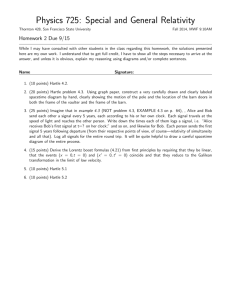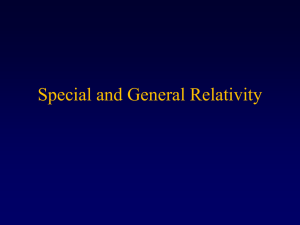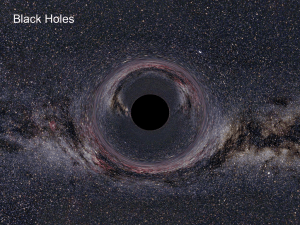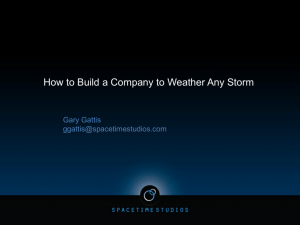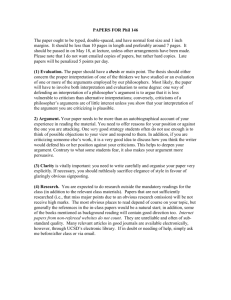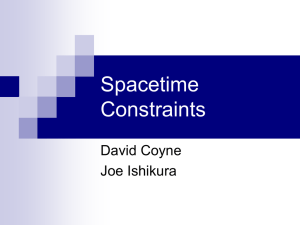07. Philosophical Consequences I. Interpretations of Special Relativity
advertisement
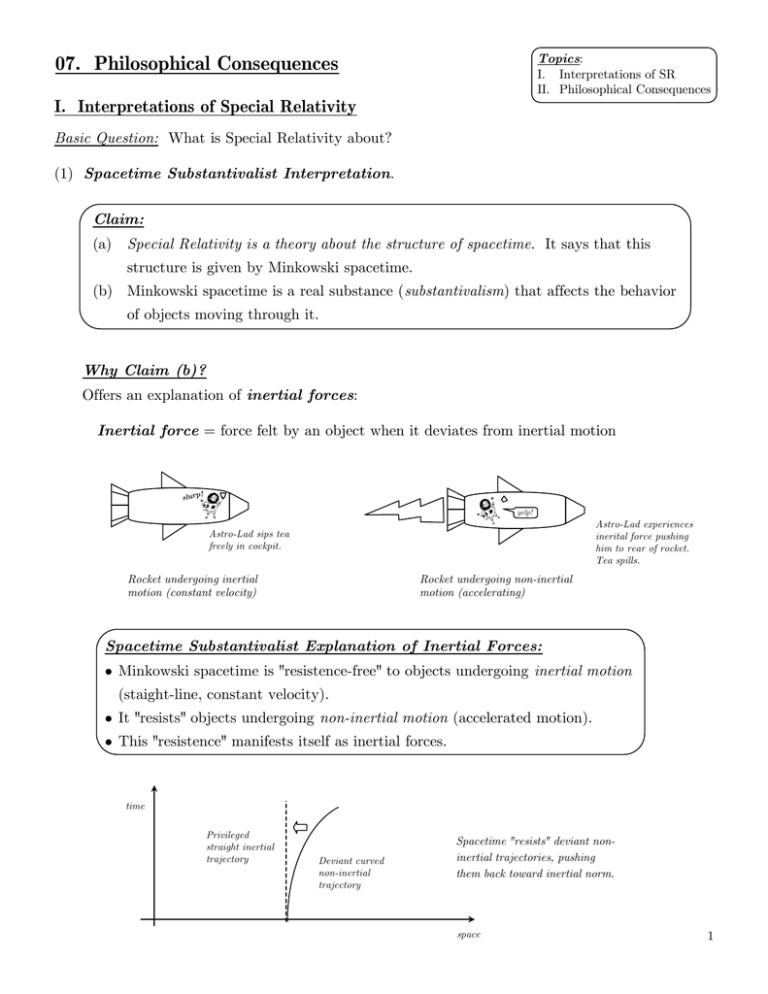
Topics: I. Interpretations of SR II. Philosophical Consequences 07. Philosophical Consequences I. Interpretations of Special Relativity Basic Question: What is Special Relativity about? (1) Spacetime Substantivalist Interpretation. Claim: (a) Special Relativity is a theory about the structure of spacetime. It says that this structure is given by Minkowski spacetime. (b) Minkowski spacetime is a real substance (substantivalism) that affects the behavior of objects moving through it. Why Claim (b)? Offers an explanation of inertial forces: Inertial force = force felt by an object when it deviates from inertial motion ! slurp yelp! Astro-Lad experiences inerital force pushing him to rear of rocket. Tea spills. Astro-Lad sips tea freely in cockpit. Rocket undergoing inertial motion (constant velocity) Rocket undergoing non-inertial motion (accelerating) Spacetime Substantivalist Explanation of Inertial Forces: • Minkowski spacetime is "resistence-free" to objects undergoing inertial motion (staight-line, constant velocity). • It "resists" objects undergoing non-inertial motion (accelerated motion). • This "resistence" manifests itself as inertial forces. time Privileged straight inertial trajectory Deviant curved non-inertial trajectory Spacetime "resists" deviant noninertial trajectories, pushing them back toward inertial norm. space 1 Further Claims: (i) Length contraction and time dilation are purely kinematical effects due to the structure of Minkowski spacetime. Due to disagreements over how inerital observers (with different standards of simultaneity) take spatial and temporal cross-sections of the world-tube of a physical system. (ii) Space and time are different inertial frame-dependent aspects of the fundamental frameindependent quantity of spatiotemporal length. (iii) Mass and energy are different inertial frame-dependent aspects of the fundamental frameindependent quantity of energy-momentum. ASIDE: This is the interpretation we've implicitly been using so far. (2) Dynamical Relationalist Interpretation. Claim: (a) Special Relativity is a theory about the form that dynamical laws must take. It says that such laws must be Lorentz invariant. (b) Minkowski spacetime does not exist as an independent substance; it is a mathematical object that simply encodes the dynamics associated with Lorentz transformations. (Spacetime does not exist independently of physical objects; rather, it consists merely in the dynamical relations between physical objects (relationalism).) Why Claim (b)? What kind of substance would spacetime be? What is the mechanism by which it interacts with (resists) moving objects? If it acts on objects without objects acting on it, wouldn't it violate Newton's 3rd Law (for every action there is an equal and opposite reaction)? But: What about inertial forces? How can inertial forces be explained relationally? Further Claims: (i) Time dilation and length contraction are real dynamical effects. Moving objects really contract and moving clocks really slow down. A real dynamical effect due to Lorentz-invariant laws. Not due to motion with respect to a stationary rest frame (like the aether); nor is it due to the (kinematic) structure of Minkowski spacetime. (ii) Time and space are distinct quantities. So are mass and energy. 2 II. Philosophical Consequences of Special Relativity A. Ontological Status of Objects with respect to Time Basic Question: !How do objects exist with respect to time? (a) Endurantism: Objects are 3-dimensional and endure through time. (b) Perdurantism: Objects are 4-dimensional and "perdure" (extend) over time. time 4-dim Joe extends over a spatial region and a temporal interval 3-dim Joe extends over a spatial region only 3-dim Joe at t = tf Any 3-dim slice is the Joe we experience on the street! space 3-dim Joe at t = ti space Endurantism Perdurantism Question Question What identifies Joe-at-ti with Joe-at-tf? How temporally extended is 4-dim Joe? Does Are they the same Joe? Is Baby Joe the he extend only over tf − ti? A larger/smaller same 3-dim object as Coffin Joe? interval? Over his entire history? Coffin Joe slice Baby Joe at ti − 50 Joe at ti Coffin Joe at ti + 50 Baby Joe slice The Compleat 4-dim Joe? 3 Typical Claim: Special Relativity supports perdurantism. Why? • Minkowski spacetime is 4-dim. • The Lorentz-invariant quantities associated with Minkowski spacetime (like spatiotemporal length and energy-momentum) are 4-dim quantities. But: • The dynamical relationalist interpretation of SR is compatible with endurantism. • Newtonian physics can be formulated in a 4-dim spacetime ("Galilean" spacetime). Hence there is nothing special about Special Relativity with respect to 4-dim spacetimes. • Claim: 3-dim objects can have 4-dim properties (spatiotemporal length, energy-momentum, etc) and still remain 3-dimensional. Conclusion: By itself, Special Relativity says nothing about the ontological status of objects with respect to time. (In order to say it does, we have to provide it with an intepretation.) ASIDE: How the 4-dim spacetime of Newtonian physics (Galilean spacetime) differs from the 4-dim spacetime of Special Relativity (Minkowski spacetime). Minkowski Spacetime Galilean Spacetime privileged family of absolute time slices no absolute time slices no privileged family of straights 1. 2. 3. 4. Many inertial frames; none privileged. No absolute velocity. Absolute acceleration. Absolute notion of simultaneity. no privileged family of straights 1. 2. 3. 4. 5. Many inertial frames; none privileged. No absolute velocity. Absolute acceleration. No absolute notion of simultaneity. Light-cone structure at each point. 4 B. Ontological Status of Time Basic Question: W ! hat is the ontological status of times other than the present? (a) Presentism: Only the present is real. (b) Eternalism: All times, past, present and future, are equally real. future present time present equally real past Presentism Eternalism Typical Claim: Special Relativity supports eternalism. Why? Argument #1 • Special Relativity entails space and time are not separate but combined into spacetime. • In spacetime, all events have the same ontological status. According to presentism (and common intuition)... Earth 2008 indeterminate state ? wins Present Earth 2004 Bush wins The "Present" advances and produces determinate facts out of indeterminate states A determinate fact Claim: Special Relativity denies this view... time Earth 2008 Both events are equally determinate in spacetime (i.e., both are present in a spacetime diagram) Earth 2004 space 5 BUT! • The dynamical relationalist interpretation of SR is compatible with presentism as described above. • SR is not unique in its use of spacetime diagrams. (Can be used in Newtonian physics, too.) Argument #2 Claim: The relativity of simultaneity entails that all events in spacetime coexist with each other. Earth 2008 roc ket' s lin e of worldline of rocket moving at constant speed with respect to Earth sim ulta neit y Earth 2004 NOW is my 40th birthday! Earth 2004's line of simultaneity (1) Earth 2004 judges rocket's 40th B-Day as happening in 2004. Therefore, the rocket's 40th B-Day coexists with Earth 2004. (2) Rocket judges Earth 2008 as simultaneous with her 40th B-Day. Therefore, Earth 2008 coexists with the rocket's 40th B-Day. (3) So: The Earth at 2008 coexists with the Earth at 2004! Moreover: Any three events in spacetime can play the roles of Earth 2004, Earth 2008, and the rocket. So any two events in spacetime coexist with each other. BUT! • This conflates "being simultaneous with" with "coexisting with". Is it the case that if Event A is simultaneous with Event B, then B coexists with A? What does it mean for one event to coexist with another? 6 Argument #3 Claim: Presentism minimally requires everyone to agree on what the present is at any given time. But: In Special Relativity, simultaneity is relative! There is no privileged family of simultaneity hyperplanes in Minkowski spacetime, any one of which could represent the "present" at any given time. ASIDE: In Newtonian physics, there is a privileged family of simultaneity hyperplanes: time is absolute and simultaneity is not relative. Idea: Lightcone structure in Minkowski spacetime entails that no two events will agree on the totality of events that count as the future, the totality that count as the past, and the totality that count as the present: overlap of future lightcones = events that are in the future for both A and B events that are in the future for A but not for B A • B • events that are in the future for B but not for A No matter how close A and B are, because they are dimensionless points, there will always be parts of one's future lightcone that do not intersect the other's (and vice-versa). Consequence: Mathematically, the "present" exists only at a point in Minkowski spacetime! Constrast with Galilean spacetime (the spacetime of Newtonian physics): To get Galilean spacetime, "flatten out" the lightcones... common future • • • flatten • • flatten • common present common past ASIDE: "Flattening out" the lightcones corresponds mathematically to taking the "Newtonian limit": letting c → ∞ (or v/c → 0). Intuitively, v/c is very, very small for physical objects moving at speeds for which Newtonian physics is a good approximation. 7 BUT! What exactly are our intuitions about the present? Is the "manifest image" of our everyday experience of the present really incompatible with the "scientific image" given by Special Relativity? Note: Even the scientific image of the present given by Newtonian physics is at odds with our manifest image. In Galilean spacetime, the present is usually represented by an instantaneous 3-dim hypersurface. Do we really experience the present as an instant? What does our everyday experience of the "present" suggest? Specious present = The present as experienced by a living organism. organism specious present (temporal extent) human 0.2 seconds. (Single thought/experience) gnat 0.02 seconds Brachiosaurus 2.0 seconds Suggests the following definitions: perhaps depends on organism's metabolism Idea: The present is not experienced as instantaneous, but rather extended over time, and how it's experienced may depend on things like the metabolism of the orgranism. Gibson and Pooley (2006) NOW = temporally extended spacetime region occupied by an object during its specious present. Stein present of NOW = Region bounded by the past lightcone of the future boundary of NOW, and the future lightcone of the past boundary of NOW. Joe's NOW (i.e., 4-dim Joe extending 0.2s) future boundary of Joe's NOW Stein present of Joe's NOW past boundary of Joe's NOW 60,000km 60,000km The Stein present of Joe's NOW extends very far in space (60,000km = distance light travels in 0.2s), but it's not global. However it encompasses most humans Joe comes into contact with, all of whom can agree on its status as the "present". 8 Key Feature of Stein present of Joe's NOW: Encompasses all events that can causally interact with Joe during his specious present. Claim: The Stein present of (an organism's) NOW is sufficient to ground the intuitions of the presentist, while at the same time being compatible with Special Relativity. Maybe these intuitions do not extend further than 60,000km away. (Seems reasonable!) Maybe the concept of a global instantaneous absolute present isn't a part of our intuitions about the present (our manifest image of the present), but rather is an artifact of the Newtonian scientific image. C. Ontological Status of Change Basic Question: !Is change (becoming) real? (a) Heracliteanism: Becoming (change) is fundamentally real. (b) Parminedeanism: Being is fundamentally real; change is an illusion. Typical Claim: Special Relativity supports Parminedeanism. Why? Our manifest image of Becoming indicates that there should be an absolute distinction between (a) events that have become, (b) events that coexist and are in the process of becoming, (c) events that have yet to become. But: If this distinction is made in terms of (a) events in the past, (b) Events in the present, and (c) Events in the future, then in Special Relativity there is no such absolute distinction! Manifest Image of Becoming (?) D A • • • • C Imcompatible with Minkowski spacetime structure • common future B common present A D • • B • C common past A and B coexist. C has become. D has yet to become. A and B do not coexist. C has become for B but not for A. D has yet to become for A but not for B. 9 However: Let's see if we can make the manifest image of Becoming as compatible as possible with Minkowski spacetime structure and see if it satisfies our intuitions. Definitions (a) Object A has become with respect to object B just if A is in the past lightcone of the Stein Present of B's NOW. (b) Objects A and B coexist just if A falls within the Stein Present of B's NOW and B falls within the Stein Present of A's NOW. (c) Object A has yet to become with respect to object B just if A is in the future lightcone of the Stein present of B's NOW. D future lightcone of Stein present of A's NOW • • Stein present of A's NOW B A • C past lightcone of Stein present of A's NOW A and B coexist. C has become for A and B. D is yet to become for A and B. Basic Idea: Because most (all?) humans will agree on the Stein present of any one human's NOW, they will also agree on the future with respect to this Stein present, and on the past with respect to this Stein present. So all humans will agree on which events have become, which coexist, and which are yet to become. 10
